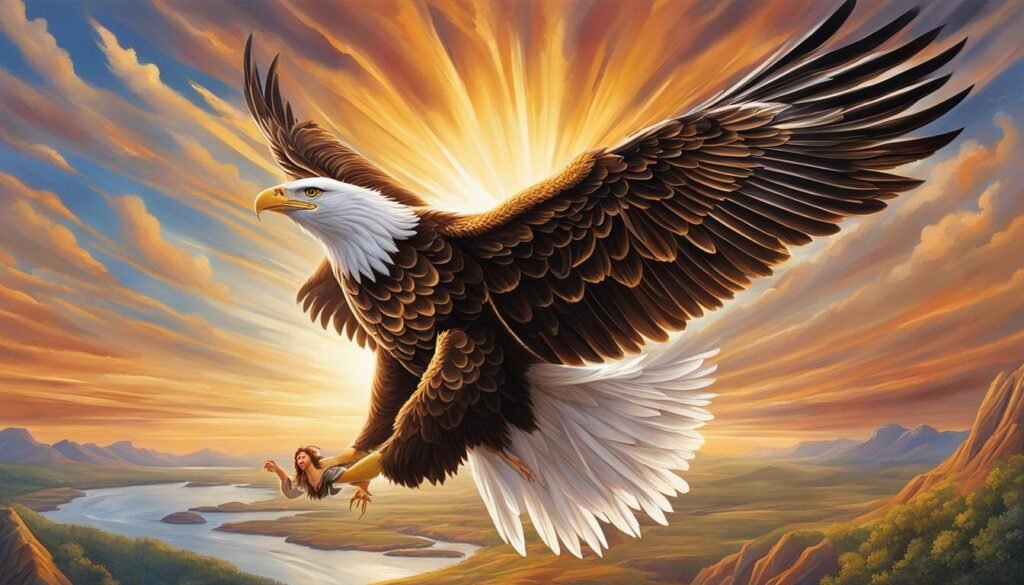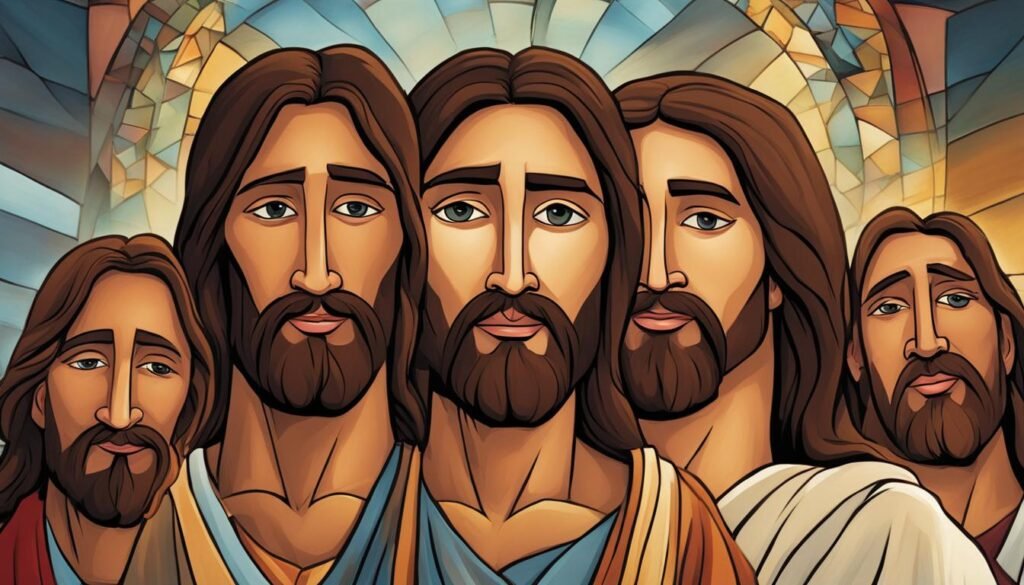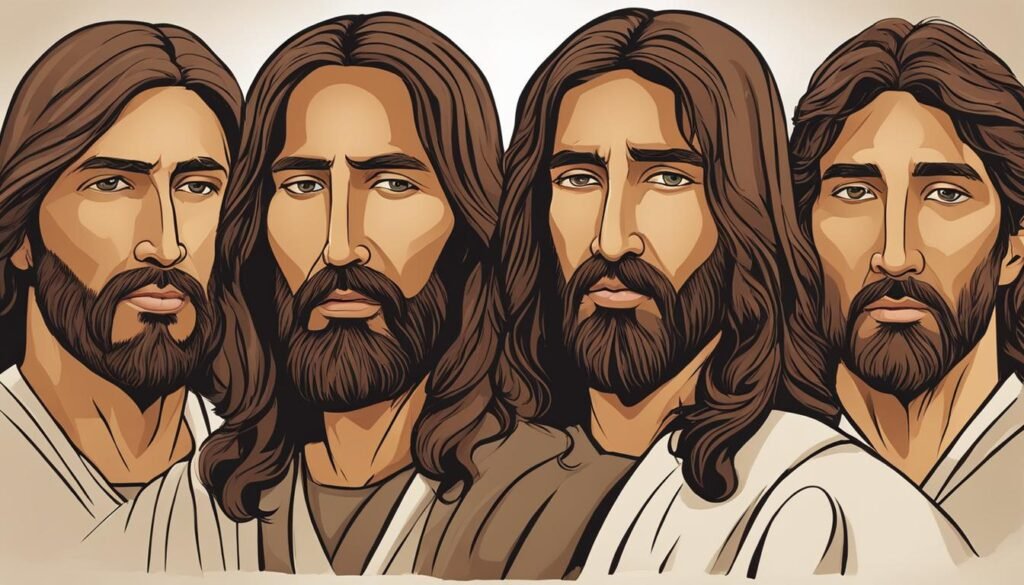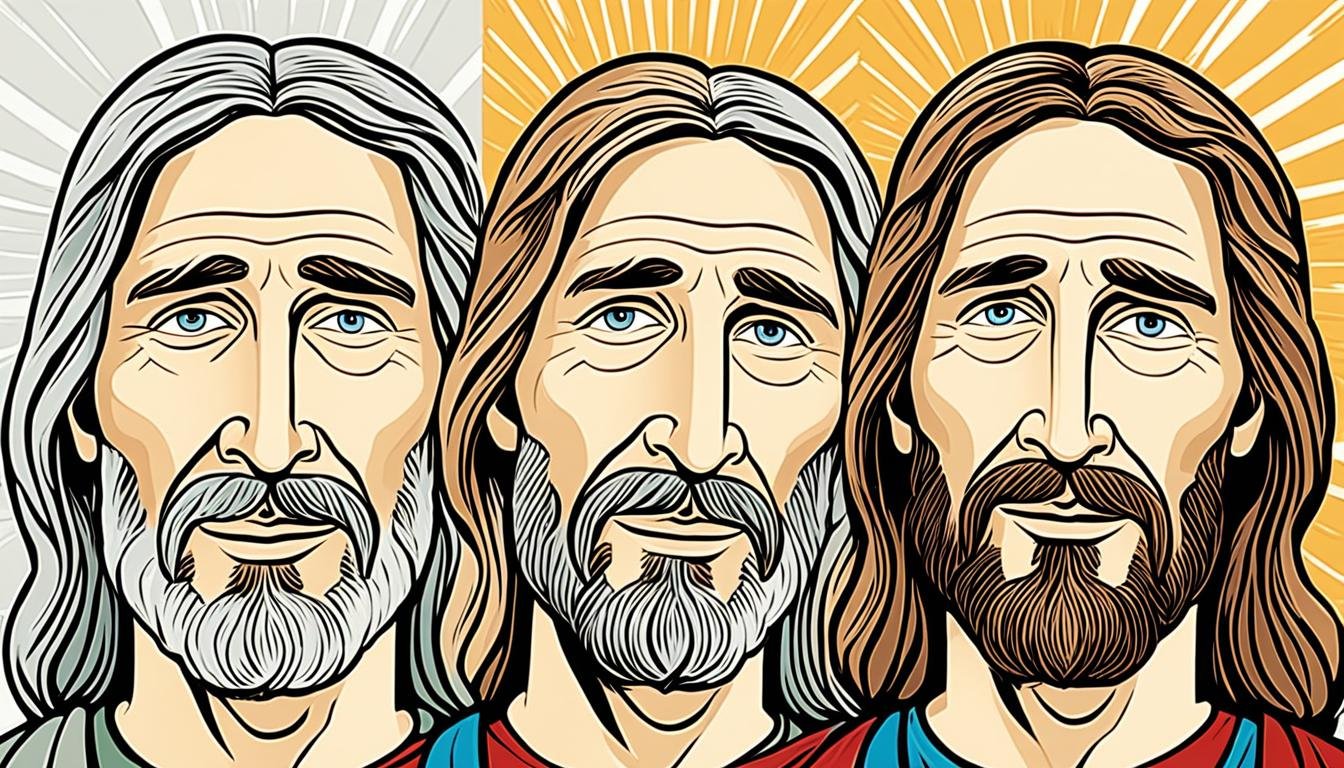The concept of the four faces of Jesus holds deep symbolism and significance in Christian faith. These faces, mentioned in Ezekiel 1:10 and Revelation 4:7, represent different aspects of Jesus’ character and nature. Understanding the symbolism behind Jesus’ faces can deepen our appreciation for who He is and how He relates to us.
In Ezekiel 1:10 and Revelation 4:7, the four faces are identified as the face of a man, the face of a lion, the face of an ox, and the face of an eagle. Each face represents a unique facet of Jesus’ identity, highlighting different qualities that He embodies.
Key Takeaways:
- The four faces of Jesus, mentioned in the Bible, symbolize different aspects of His character and nature.
- These faces are identified as the face of a man, the face of a lion, the face of an ox, and the face of an eagle.
- Each face represents specific qualities, such as Jesus’ humanity, power, service, and transcendence.
- Understanding the four faces of Jesus can deepen our relationship with Him and help us grow in our own character.
- The four faces remind us of the multifaceted nature of our Savior and his abundant love, power, and grace.
The Face of a Man
In the depiction of the four faces of Jesus, the face of a man holds significant meaning. This face represents Jesus’ humanity and his unique experience of living as a man on earth. Throughout the Gospels, we see Jesus as a man who walked, talked, laughed, and cried. He experienced the full range of human emotions and faced the same challenges and temptations that we do.
In embracing his humanity, Jesus could relate to our struggles and weaknesses, offering us comfort, understanding, and hope. He entered into our world, becoming one of us, to demonstrate God’s love and provide a way for us to connect with him on a personal level. This aspect of Jesus’ character allows us to approach him not only as our Savior and Lord but also as a compassionate friend who truly understands what it means to be human.
Jesus’ humanity is beautifully captured in the Gospels, where we witness his interactions with people from all walks of life: healing the sick, comforting the broken-hearted, displaying mercy and forgiveness, and extending kindness and love. These stories highlight his empathy, compassion, and genuine concern for humanity.
For we do not have a high priest who is unable to empathize with our weaknesses, but we have one who has been tempted in every way, just as we are—yet he did not sin.” – Hebrews 4:15
Through his perfect life as a man, Jesus not only showed us the way to live a righteous life but also became the bridge that reconciles us with God. His sacrifice on the cross, as a man, offered salvation and redemption for all who believe in him. By embracing his humanity, we are reminded of his great love and the depth of his sacrifice for us.
The Face of a Lion
The face of a lion symbolizes Jesus’ reign, victory, boldness, strength, and vigor. Jesus is described as the Lion of the tribe of Judah (Revelation 5:5), showing his kingly and majestic nature. This aspect of Jesus’ character reminds us that he is the King of kings and the Lord of lords, with the power to overcome any obstacle or enemy.
The King of Kings
In the Bible, Jesus is depicted as the rightful ruler who holds a position of authority and power over all creation. The image of a lion conveys his regal nature and majestic presence. Just as a lion is the king of the jungle, Jesus is the ultimate king, with dominion and authority over every realm.
“And one of the elders said to me, ‘Weep no more; behold, the Lion of the tribe of Judah, the Root of David, has conquered, so that he can open the scroll and its seven seals.’” – Revelation 5:5
The Victorious Savior
The lion is also a symbol of victory, representing Jesus’ triumph over sin, death, and the forces of darkness. Just as a lion overcomes its prey, Jesus has overcome the greatest enemy of humanity through his sacrificial death and resurrection. He is the victorious Savior who has conquered sin and offers eternal life to all who believe in him.
Boldness, Strength, and Vigor
The lion is known for its courage, strength, and energy. In the same way, Jesus embodies these qualities in his character and ministry. He fearlessly confronted religious hypocrisy, challenged the powers of evil, and demonstrated supernatural strength through his miracles. The face of a lion reminds us of Jesus’ boldness, unwavering strength, and boundless vigor.
In the Christian faith, Jesus’ power and authority as depicted by the face of a lion serve as a source of inspiration and hope for believers. His reign extends far beyond earthly boundaries, and he empowers his followers to walk in victory and boldness, knowing that they serve the King of kings.
“The Lord is a roaring lion; his power and authority cannot be challenged. He is a fierce protector of his people and a conqueror of every enemy.”
The Face of an Ox
In the depiction of the four faces of Jesus, the face of an ox represents his role as a servant. Similar to the nature of an ox, Jesus willingly took on the burdens of humanity, bearing the weight of our sins on the cross. By offering himself as a ransom for many, Jesus exemplified humility, selflessness, and the importance of serving others.
Just as an ox is a beast of burden, Jesus took on the immense task of redeeming humanity through his sacrificial death. In Mark 10:45, Jesus himself declared, “For even the Son of Man did not come to be served, but to serve, and to give his life as a ransom for many.” This statement highlights the servant heart of Jesus and his mission to serve and bring salvation to all.
The image of Jesus as an ox invites us to reflect on the virtues of humility and selflessness. It challenges us to embrace a life of service to others, just as Jesus did during his time on earth. As believers, we are called to follow in Jesus’ footsteps and embody the servant nature that he demonstrated.
“For even the Son of Man did not come to be served, but to serve, and to give his life as a ransom for many.” – Mark 10:45
By imitating Jesus as an ox, believers can actively seek opportunities to serve those in need, demonstrating love, compassion, and selflessness. This can be expressed through acts of kindness, volunteering, or using our talents and resources to benefit others.
Living out the face of an ox in our lives not only deepens our relationship with Jesus but also allows us to make a positive impact on the world around us. It reminds us that greatness is found in service, and true fulfillment comes from selflessly pouring ourselves out for the benefit of others.
Key Lessons from Jesus as an Ox:
- Embrace humility and selflessness
- Seek opportunities to serve others
- Use your talents and resources to benefit those in need
- Find fulfillment in selflessly pouring yourself out for others
The Face of an Eagle
The face of an eagle represents Jesus’ divine and transcendent nature. Just as an eagle soars above the earthly realm, Jesus dwells in heavenly places, beyond the constraints of this world. His eagle-like qualities reveal his power, freedom, and ability to offer us victory over life’s challenges.
In Scripture, the imagery of an eagle is often associated with God’s deliverance and protection. In Deuteronomy 32:11, it says, “Like an eagle that stirs up its nest and hovers over its young, that spreads its wings to catch them and carries them aloft, the Lord alone led him.” This passage depicts God’s care and guidance, lifting us up and carrying us to a place of safety and triumph.
Similarly, the face of an eagle in Jesus represents his divine intervention in our lives. Just as an eagle can spot its prey from great heights, Jesus sees and knows our needs before we even ask. He is ready to swoop down and rescue us, providing the strength and protection we need.
“But those who hope in the Lord will renew their strength. They will soar on wings like eagles; they will run and not grow weary, they will walk and not be faint.” – Isaiah 40:31
By embodying the characteristics of an eagle, Jesus demonstrates his ability to transcend the limitations of our human existence. He invites us to rise above our circumstances, to leave our worries and fears behind, and to experience a life of freedom and victory in him.

| Eagle-Like Qualities of Jesus | Relevance in Our Lives |
|---|---|
| Divine power and strength | Jesus empowers us to overcome challenges and live victoriously. |
| Transcendence and freedom | Jesus invites us to rise above earthly concerns and experience the freedom he offers. |
| Provision and protection | Jesus provides for our needs and offers us shelter under his wings. |
| Divine insight and guidance | Jesus sees what we cannot and guides us on the right path. |
The Four Faces in Christian Iconography
In Christian iconography, the four faces of Jesus are often depicted in artwork to represent the different aspects of his character. These artistic representations serve as visual reminders of the multifaceted nature of Jesus’ identity and his significance in Christian faith.
For example, the face of a man is commonly portrayed to convey Jesus’ compassion, empathy, and his full humanity. This representation emphasizes his relatability and his understanding of the human experience.
The face of a lion, on the other hand, symbolizes Jesus’ power, authority, and victory. It serves as a reminder of his divine kingship and his ability to overcome any obstacle or enemy. This depiction showcases his strength and majesty.
Additionally, the face of an ox is often used to portray Jesus as a servant. This image highlights his selflessness, humility, and willingness to sacrifice for others. It points to his role as the ultimate example of servanthood.
Lastly, the face of an eagle represents Jesus’ transcendent nature. Like an eagle soaring high above the earthly realm, Jesus transcends human limitations and dwells in heavenly places. This portrayal highlights his divine nature and his eternal existence.
“The symbolism in Christian iconography through the four faces of Jesus allows believers to contemplate and appreciate the diverse aspects of his character, encouraging a deeper understanding of his love, power, and grace.”
These artistic depictions of the four faces of Jesus in Christian iconography not only enhance the visual experience but also serve as a visual catechism, teaching believers about the different dimensions of Jesus’ character and the lessons they can learn from each aspect. They provide a tangible representation of the complexities of Jesus’ identity and invite believers to reflect on his various roles and attributes.
| Face | Symbolism |
|---|---|
| Face of a Man | Compassion, Empathy, Humanity |
| Face of a Lion | Power, Authority, Victory |
| Face of an Ox | Servanthood, Sacrifice, Humility |
| Face of an Eagle | Transcendence, Divinity, Eternity |
By incorporating these visual representations into Christian art, believers are reminded of the profound symbolism behind the four faces of Jesus, deepening their understanding of his character and reinforcing their faith. These icons and artworks become powerful tools for contemplation, worship, and spiritual growth.
Through Christian iconography, the four faces of Jesus come to life, touching the hearts and minds of believers across generations. These depictions serve as a testament to the enduring influence and significance of Jesus’ multifaceted nature in the Christian faith.
The Four Faces in Scripture Interpretations
Throughout history, scholars and theologians have delved into the interpretation of the four faces of Jesus as mentioned in Ezekiel and Revelation. These faces hold great significance and offer insights into the multifaceted nature of Christ. Various interpretations have emerged, shedding light on different aspects of Jesus’ character and his relationship with humanity.
Correlation with the Four Roles of Christ
One interpretation sees a correlation between the four faces of Jesus and the four roles of Christ described in the four Gospels: Matthew, Mark, Luke, and John. According to this viewpoint, the face of a man represents Jesus as the compassionate and merciful Savior portrayed in the Gospel of Matthew. The face of a lion symbolizes Jesus as the triumphant and powerful conqueror depicted in the Gospel of Mark. The face of an ox embodies Jesus as the humble and sacrificial servant exemplified in the Gospel of Luke. Finally, the face of an eagle represents Jesus in his heavenly and transcendent nature, as seen in the Gospel of John.
“The four faces of Jesus reflect the diverse aspects of his character and mission, capturing the essence of who he is and what he accomplished during his time on earth.”
Representation of God’s Nature and Character
Another interpretation suggests that the four faces of Jesus serve as representations of different aspects of God’s nature and character. The face of a man reveals Jesus’ divine incarnation, demonstrating God’s desire to intimately connect with humanity. The face of a lion unveils God’s supreme authority and power, showcasing his sovereignty over all creation. The face of an ox portrays the divine attribute of selfless service and sacrificial love. Lastly, the face of an eagle signifies God’s transcendence and his ability to lift us up to a higher spiritual plane.
Deepening Our Understanding
These interpretations of the four faces of Jesus offer profound insights into his nature and illuminate the relationship between humanity and the divine. By reflecting on these interpretations, believers can deepen their understanding of who Jesus is and how he relates to us. Moreover, they provoke thoughtful reflection on our own lives, encouraging us to embody these diverse aspects of Jesus’ character in our interactions with others and in our personal journeys of faith.
To visually represent the four faces of Jesus, here is an artist’s depiction:

The Four Faces and Gospel Appeal
The four faces of Jesus hold a unique appeal, connecting with different audiences in powerful ways. Each face represents a different aspect of Jesus’ character, offering something meaningful to individuals from all walks of life.
- The face of a man speaks to Jesus’ humanity, emphasizing his ability to relate to our struggles and experiences. It reminds us that Jesus walked this earth as a man, facing the same challenges and temptations we encounter. This relatability resonates with those who seek a Savior who understands their daily realities.
- The face of a lion symbolizes Jesus’ power and authority. It appeals to those who long for a strong and victorious Savior, one who can overcome any obstacle or enemy. This depiction highlights Jesus’ reign and victory, inspiring confidence and trust in his ability to bring about triumph in our lives.
- The face of an ox represents Jesus’ servant heart, emphasizing his willingness to serve and sacrifice for others. This aspect of Jesus’ character resonates with individuals who value selflessness and the importance of putting others before themselves. It calls us to emulate his example in our own lives, cultivating a spirit of sacrificial love and service.
- The face of an eagle signifies Jesus’ transcendence and divine nature. It speaks to those who long for something beyond the confines of this world, who seek a connection to the divine and a higher purpose. This aspect of Jesus’ character reminds us that he is not bound by earthly limitations, offering hope and inspiration for those who desire a deeper spiritual connection.
Through these different appeals, the four faces of Jesus create a Gospel that is inclusive and relatable to people from various backgrounds and perspectives. Whether someone seeks understanding, power, service, or transcendence, Jesus’ multifaceted character allows him to meet individuals where they are and connect with them on a personal level.
Living Out the Four Faces in the World
As believers, we are called to imitate Christ and express his character in our daily lives. To live out the four faces of Jesus in the world, we must strive to embody his different qualities and apply them to our interactions and actions.
Embracing Jesus’ Humanity
Being authentically human means embracing the full range of our emotions and experiences, just as Jesus did during his time on earth. We can connect with others by showing compassion, empathy, and understanding. By treating others with kindness and respect, we reflect Jesus’ character as a man who walked among us.
Standing Bold as a Lion
Jesus’ face as a lion represents his power and authority. In the face of sin and the pressures of the world, we need to stand boldly and fearlessly for what is right and just. By living according to God’s word and principles, we can demonstrate the strength and courage that comes from following Jesus.
Serving and Sacrificing Like an Ox
The face of an ox symbolizes Jesus’ role as a servant, willing to lay down his life for others. We can embody this aspect of Jesus’ character by serving those around us, putting their needs before our own. Whether it’s volunteering, helping a neighbor, or sacrificing our time and resources, we can reflect Jesus’ selflessness and love.
Rising Above Challenges Like an Eagle
The face of an eagle represents Jesus’ transcendence and his ability to soar above the challenges of this world. We can emulate this aspect of Jesus’ character by maintaining a heavenly perspective and not being weighed down by earthly concerns. By relying on God’s strength and trusting in His promises, we can overcome obstacles and experience victory in our lives.
In applying Jesus’ character to our daily lives, we become powerful witnesses for Christ. Our workplaces, schools, and communities become platforms for us to display the love, power, and grace of Jesus to those around us. By living out the four faces of Jesus, we can make a positive impact and inspire others to encounter the transformative power of the Gospel.
| Face of Jesus | Qualities | Application in Daily Life |
|---|---|---|
| Face of a Man | Compassion, empathy, understanding | Show kindness and respect towards others, connect with their struggles |
| Face of a Lion | Power, authority, boldness | Stand up for righteousness, speak out against injustice, and be a voice for the voiceless |
| Face of an Ox | Servanthood, sacrifice, humility | Serve others, prioritize their needs, and demonstrate selflessness |
| Face of an Eagle | Transcendence, victory, heavenly perspective | Trust in God’s promises, rise above challenges, and find strength in Him |
The Mystery of the Four Faces
The face of an eagle, representing the hidden divine life within us, is described as a mystery. As believers, we may experience a transcendence that others may not understand or see. This hidden divine life allows us to overcome earthly frustrations, soar above challenges, and live a life that is pleasing to God. Embracing this mystery and relying on the divine life within us enables us to live victoriously and be a testimony to others.
Embracing the Hidden Divine Life
When we speak of the mystery of the four faces of Jesus, we refer to the mystical nature of the hidden divine life that resides within us. Like an eagle soaring above the world, this hidden divine life transcends the limitations of the earthly realm and empowers us to live according to God’s purpose.
Just as an eagle rises above the storm clouds, so too does our hidden divine life enable us to rise above the challenges and temptations of this world.
Through the power of the Holy Spirit, believers can tap into this hidden divine life and access strength, wisdom, and guidance beyond human understanding. It is a mystery that we can only begin to comprehend when we surrender ourselves to God and allow Him to work in and through us.
Living a Transcendent Life
- Overcoming earthly frustrations: The hidden divine life enables us to rise above the frustrations and disappointments of life. It gives us the perspective to see beyond our present circumstances and find hope in the eternal promises of God.
- Soaring above challenges: Just as an eagle soars effortlessly above the mountaintops, our hidden divine life equips us to face and overcome the challenges that come our way. It empowers us to navigate through trials, setbacks, and obstacles with grace and strength.
- Living a life that pleases God: The hidden divine life within us enables us to live a life that is pleasing to God. It guides our thoughts, actions, and choices, aligning them with God’s will and purpose. It empowers us to love and serve others selflessly, reflecting the character of Jesus.
As we embrace and rely on the mystery of the hidden divine life, we experience transformation and become a living testament to God’s power and grace. The more we surrender to this mystery, the more we are filled with the love, joy, peace, and purpose that can only come from our divine Creator.

| Symbol | Representation |
|---|---|
| The Face of a Man | Jesus’ normal human life, compassion, and empathy |
| The Face of a Lion | Jesus’ power, authority, and reign as the King of kings |
| The Face of an Ox | Jesus’ willingness to serve and sacrifice for others |
| The Face of an Eagle | Jesus’ transcendent and divine nature |
The Four Faces in Personal Growth
Reflecting on the four faces of Jesus can be a powerful tool for personal growth and transformation. By embracing the qualities represented by each face – humanity, power, service, and transcendence – we can develop a well-rounded character that mirrors the image of Christ.
“Embracing the qualities represented by each face – humanity, power, service, and transcendence – we can develop a well-rounded character that mirrors the image of Christ.”
This growth journey involves allowing the cross to work in our lives, laying aside our own desires and embracing the qualities of Christ. Through this process, we can become more like Jesus and fulfill our purpose as his disciples.
Embracing Humanity
Embracing the humanity of Jesus teaches us to love and understand one another. Just as Jesus walked among us, experiencing the joys and sorrows of human life, we are called to empathize with others and extend grace and compassion.
Unleashing Power
The power of Jesus enables us to overcome sin and face life’s challenges with courage and confidence. By tapping into his strength, we can conquer our fears and live victoriously, knowing that we are empowered by the Holy Spirit.
Serving Selflessly
Jesus’ example as a servant motivates us to serve others selflessly. As we lay down our own desires and prioritize the needs of others, we reflect the sacrificial love of Christ and spread his message of hope and redemption.
Soaring in Transcendence
Embracing the transcendence of Jesus allows us to rise above earthly limitations and live with an eternal perspective. Just as an eagle soars above the mountaintops, we can elevate our thinking and set our minds on things above, focusing on the eternal values of faith, hope, and love.
By embracing these four faces of Jesus, we embark on a transformative journey of personal growth, becoming more like Christ every step of the way.
| Qualities | Description |
|---|---|
| Humanity | Embracing the joys and sorrows of human life, empathizing with others, and extending grace and compassion. |
| Power | Overcoming sin and facing challenges with courage and confidence, tapping into the strength empowered by the Holy Spirit. |
| Service | Serving others selflessly, reflecting Christ’s sacrificial love, and spreading his message of hope and redemption. |
| Transcendence | Rising above earthly limitations, living with an eternal perspective, and focusing on the values of faith, hope, and love. |
Conclusion
The four faces of Jesus hold immense significance in the Christian faith, serving as powerful symbols that represent different aspects of his character and nature. By delving into the meaning behind these faces and embodying their qualities, believers can deepen their relationship with Jesus, cultivate their personal character, and become impactful witnesses in the world.
These four faces, each unique and distinct, remind us of the multifaceted nature of our Savior. The face of a man reflects Jesus’ empathy and compassion, offering us a relatable figure who understands our joys and sorrows. The face of a lion showcases his power and authority, portraying him as the victorious and majestic King of kings. The face of an ox epitomizes his servant heart, inspiring us to embrace selflessness and sacrificial love. Finally, the face of an eagle symbolizes his transcendence, inviting us to rise above the limitations of this world and discover divine strength.
By understanding and embodying these four faces, believers can not only experience personal growth and transformation but also become ambassadors of Christ’s love, grace, and power. Aligning ourselves with Jesus’ multifaceted character enables us to live a life that reflects his image, embody his teachings, and fulfill our purpose as his disciples. As we grasp the significance of these faces, we are reminded of the rich and profound nature of Jesus and are inspired to navigate life’s challenges with faith, hope, and unwavering trust in our Savior.
FAQ
What are the four faces of Jesus?
The four faces of Jesus are mentioned in Ezekiel 1:10 and Revelation 4:7. They are identified as the face of a man, the face of a lion, the face of an ox, and the face of an eagle.
What does the face of a man represent?
The face of a man represents Jesus’ normal human life as seen throughout the Gospels. It symbolizes his compassion, empathy, and his ability to connect with us on a personal level.
What does the face of a lion symbolize?
The face of a lion represents Jesus’ reign, victory, boldness, strength, and vigor. It signifies his kingly and majestic nature and reminds us that he is the King of kings and the Lord of lords.
What does the face of an ox represent?
The face of an ox represents Jesus’ willingness to serve and sacrifice for others. It symbolizes his humility, selflessness, and the importance of serving others as he did on the cross.
What does the face of an eagle signify?
The face of an eagle signifies Jesus’ divine and transcendent nature. It represents his ability to soar above the earthly realm and reminds us that he has the power to lift us up and give us victory over challenges.
How are the four faces of Jesus depicted in Christian art?
In Christian iconography, the four faces of Jesus are often depicted in artwork to represent different aspects of his character. The face of a man may be shown to convey compassion, while the face of a lion represents power and authority.
How have scholars interpreted the significance of the four faces of Jesus?
Scholars and theologians have offered various interpretations of the four faces. Some see a correlation between these faces and the four roles of Christ described in the Gospels, while others view them as representations of God’s nature and character.
How do the four faces of Jesus appeal to different audiences?
The face of a man appeals to those seeking Jesus’ humanity and relatability. The face of a lion appeals to those looking for a strong and victorious Savior. The face of an ox appeals to those valuing selflessness and sacrifice. The face of an eagle appeals to those longing for something beyond this world.
How can we live out the four faces of Jesus in the world?
We can strive to be authentically human, bold against sin, willing to serve others, and transcendent in rising above worldly challenges. By embodying these qualities, we can be a powerful witness for Christ.
What is the mystery of the face of an eagle?
The face of an eagle represents the hidden divine life within us. It allows believers to overcome earthly frustrations and live a life pleasing to God, serving as a testimony to others.
How can reflecting on the four faces of Jesus aid personal growth?
By embracing the qualities represented by each face – humanity, power, service, and transcendence – we can develop a well-rounded character mirroring the image of Christ and fulfill our purpose as disciples.
What is the significance of the four faces of Jesus in Christian faith?
The concept of the four faces represents different aspects of Jesus’ character and nature. Understanding and embodying these faces deepens one’s relationship with Jesus, fosters personal character growth, and enables believers to be powerful witnesses in the world.
Source Links
- http://www.thesanctuarytoday.org/portfolio-item/the-four-faces-of-god/
- https://www.resilientlifechurch.com/blog/2020/3/10/four-faces-of-god
- https://livingtohim.com/2011/06/four-faces-of-expressing-christ/

I’m Benjamin, a passionate spiritual seeker and creator of Verses and Prayers. Alongside my girlfriend Emma and our pet lizard Mulle, I cherish family life, enjoy exploring new places, and am deeply involved in my church community. My love for reading and singing biblical verses inspires every aspect of my journey.

